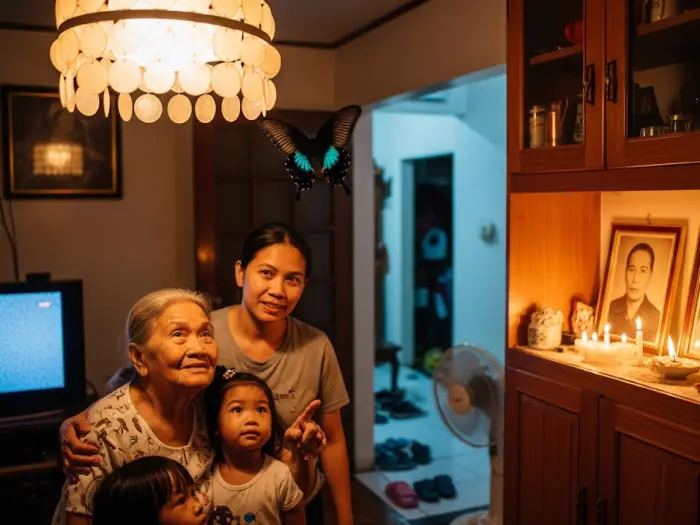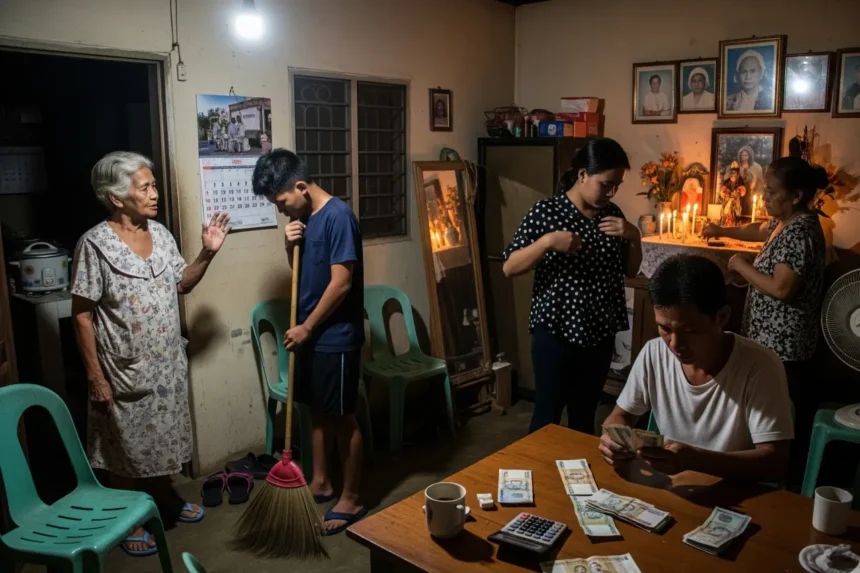Picture this: It’s late, and you’re about to sweep some crumbs off the floor when a familiar voice echoes in your head-it’s your lola’s, clear as day, warning you, “Huwag magwalis sa gabi!” You pause, broom in hand, and laugh it off. But you end up leaving the mess for tomorrow anyway. Just in case.
- 🧹 1. Don’t Sweep the Floor at Night
- ✋ 2. An Itchy Palm Means Money is Coming
- 💸 3. Don’t Pay Debts at Night
- ⚫ 4. Wear Polka Dots on New Year’s Eve
- 👛 5. Never Give an Empty Wallet as a Gift
- 👰 6. Don’t Try On Your Wedding Dress Before the Big Day
- ♊ 7. Siblings Shouldn’t Marry in the Same Year (Sukob)
- 🎤 8. Singing While Cooking Will Make You Marry an Old Person
- 👟 9. Don’t Give Shoes to Your Partner as a Gift
- 💍 10. A Dropped Ring or Veil During a Wedding is a Bad Omen
- 👻 11. Don’t Go Straight Home From a Wake (Pagpag)
- 🦋 12. A Black Butterfly in the House is a Visiting Spirit
- 💅 13. Don’t Cut Your Nails at Night
- 📸 14. The Middle Person in a Photo of Three Will Die First
- 💧 15. Don’t Let Your Tears Fall on the Coffin
- Quick Summary: All 15 Superstitions
- Frequently Asked Questions
- Our Beautiful, Quirky Filipino Superstition Culture
That’s the undeniable power of Filipino superstitions. These are the pamahiin we all grew up with, a unique collection of old beliefs and warnings that often defy logic but are deeply woven into the fabric of our Filipino culture. Passed down from our grandparents, they’re the ‘just-in-case’ rules we follow, often purely by instinct.
But have you ever stopped to wonder where these fascinating beliefs actually came from? Is there a logical reason we shouldn’t pay debts at night? In this article, we’ll take a fun and insightful journey through 15 famous Filipino superstitions about life’s three biggest concerns: money, love, and death. Get ready to uncover the surprising origins and hidden stories behind the warnings you probably still follow.
🧹 1. Don’t Sweep the Floor at Night
The Belief: This is a classic, top-tier pamahiin. Sweeping at night, especially sweeping dust and dirt out the main door, is believed to sweep your swerte (good luck) and fortune away. You are literally pushing your blessings out into the darkness.
The Scene:
Anak: “Ma, wawalisin ko lang ‘tong sahig.”
Mama: “Nako, gabi na! Huwag kang magwalis ngayon, bukas na ‘yan. Pinapalabas mo ang grasya!”
The Roots: This belief is a potent cultural cocktail. It likely has its origins in pre-colonial animist beliefs that spirits and unseen entities are most active at night. Sweeping could disturb them, or worse, you could sweep out a benevolent spirit protecting the home. This was heavily reinforced by Chinese traders and their feng shui principles, which emphasize the careful flow of luck and energy (chi). This superstition has been around for centuries, long before the Spanish arrived.
Around the World: This isn’t just a Pinoy thing. A very similar belief exists in parts of India, where sweeping after sunset is said to anger the goddess Lakshmi, the goddess of wealth. In some West African cultures, it’s also believed to bring bad luck or even sweep a family member’s spirit away.
The Logical Take: Let’s be practical. Back in the day, homes were lit by flickering candles or a dim gasera. Floors were often uneven soil or dark wood. If you swept at night with such poor lighting, you could easily sweep out a fallen earring, a valuable button, or a coin along with the dirt. Our ancestors weren’t paranoid; they were resourceful. This was a clever, fear-based way to say, “Clean when you can actually see what you’re doing, sayang ang mga gamit!” 😉

✋ 2. An Itchy Palm Means Money is Coming
The Belief: If your palm suddenly starts itching, get ready! It’s a sure sign that you’re about to receive an unexpected windfall of money. The crucial part is not to scratch it with your other hand, as that could “block” the luck. Instead, you should rub it on a piece of wood (“knock on wood”).
The Scene:
Friend 1: “Grabe, ang kati ng palad ko!”
Friend 2: “Uy, ‘wag mong kamutin! May darating na pera sa’yo! Baka may manlilibre o may magbabayad ng utang!”
The Roots: This is one of the most ancient and widespread superstitions in the world. Its origins are often traced back to the Saxons in Europe, long before Christianity. They believed rubbing an itchy palm on silver would cure diseases, which eventually morphed into an itchy palm being associated with receiving silver (i.e., money). This belief most likely arrived in the Philippines through Spanish and European influence.
Around the World: This is a global superstar of superstitions. In many Western cultures, an itchy left palm means you’ll have to give money away, while an itchy right palm means you’ll receive it. The version in the Philippines is usually simpler: any itchy palm is good news.
The Logical Take: Medically speaking, an itchy palm is usually just… an itchy palm. It could be caused by anything from dry skin (eczema), a mild allergic reaction, or just a random nerve tingle. But of course, this is one of the more harmless and optimistic beliefs out there. If it makes you feel hopeful for a surprise GCash transfer from a tita, where’s the harm, right? 😂
💸 3. Don’t Pay Debts at Night
The Belief: Paying someone you owe money to (magbayad ng utang) after the sun has set is a huge no-no. It’s believed that just like the darkness of the night, your finances will turn dim. The money will flow away from you, and you might find yourself in a constant cycle of debt.
The Scene:
Friend 1: “Uy bes, bayaran na kita sa utang ko sa’yo ha.” (It’s 8 PM)
Friend 2: “Hala, ‘wag ngayon! Gabi na, masama maglabas ng pera. Bukas na lang sa umaga para swerte.”
The Roots: This is another superstition with strong ties to Chinese business practices and feng shui, which were very influential in the Philippines even before Spanish colonization. In this philosophy, nighttime is a period of rest and replenishment. Spending or giving away money during this time disrupts the natural cycle of “rest” for your finances, leading to bad financial chi.
Around the World: While not as widespread as the itchy palm, similar beliefs about not handling money at night exist in other cultures, particularly in parts of China and Vietnam. It’s often tied to the idea that transactions in the dark are shady or will lead to misfortune.
The Logical Take: Before the age of online banking and 24/7 convenience stores, most business was done during the day. Night was dark and considered more dangerous. Handling cash in the dark was a security risk-you could be easily robbed, or you could miscount the bills in the poor lighting. So, the advice “don’t exchange money at night” was actually very sound safety and financial advice, cleverly disguised as a superstition. Today, with digital payments, this one has lost a bit of its sting, but the feeling still lingers for many. 😉

⚫ 4. Wear Polka Dots on New Year’s Eve
The Belief: Come Media Noche (New Year’s Eve dinner), out come the polka dots! Wearing clothes with round patterns is a must-do for many Filipinos. Why? Because the round shape of the dots mimics coins, and it’s believed that this will attract a fortune and a prosperous year ahead. The more dots, the more money!
The Scene:
Tita: “O, apo, isuot mo ‘tong damit mo mamaya. Bilog-bilog ‘yan para maraming pera sa New Year!”
Teenager: “Tita naman, I have my own outfit na…” (but ends up wearing the polka dot shirt anyway) 😂
The Roots: This tradition is relatively modern compared to the others and is a fun fusion of Western fashion trends and Chinese symbolism. While celebrating the New Year with noise and round objects (like fruits) is an old Chinese tradition to bring good luck, the specific focus on polka dot clothing became popular in the Philippines in the latter half of the 20th century. It’s a visual and easy-to-follow version of an older belief.
Around the World: The specific “polka dots for New Year’s” is uniquely and famously Filipino. However, other cultures have similar practices. For example, in Brazil, many people wear white for peace, while in Spain, they eat 12 grapes at midnight for 12 months of good luck.
The Logical Take: There is, of course, no scientific link between dotted fabric and your bank account. But this tradition is all about starting the year with a positive, hopeful mindset. It’s a fun, collective activity that brings families together and makes everyone feel like they’re actively welcoming good fortune. It’s less of a superstition and more of a festive, feel-good tradition.
👛 5. Never Give an Empty Wallet as a Gift
The Belief: Gifting a wallet or a purse (pitaka) is a thoughtful gesture, but according to superstition, you must never, ever give one that’s completely empty. It’s believed that doing so destines the recipient to a future of financial struggles. You must always include at least one crisp bill or a few shiny coins inside.
The Scene:
Gifter: “Happy birthday! Here’s a new wallet for you.”
Receiver: “Wow, thanks! Uy, may laman! Salamat!”
Gifter: “Syempre, para suwertehin ka!”
The Roots: This belief is found in many cultures and is tied to the concept of sympathetic magic-the idea that “like produces like.” By putting money in the wallet, you are setting a precedent. You’re not just giving an object; you’re giving the state of having money in it. This has strong parallels with feng shui and other ancient beliefs about starting things off on the right foot.
Around the World: This is a very common superstition across the globe. It’s practiced in China, Greece, and many parts of Eastern Europe. In some cultures, a lump of coal is also placed inside a new home for good luck, working on the same principle of not starting something empty.
The Logical Take: Let’s be honest, getting a gift is nice, but getting a gift with a little surprise cash inside is even nicer! 😄 On a deeper level, this is a beautiful gesture. It’s a tangible way of saying, “I’m not just giving you a thing; I’m giving you my sincere wish for your prosperity and success.” It elevates a simple gift into a meaningful blessing.

👰 6. Don’t Try On Your Wedding Dress Before the Big Day
The Belief: A bride-to-be trying on her full wedding attire-dress, veil, and all-before the wedding day is considered extremely bad luck. It’s said to invite misfortune, and some even believe it could cause the wedding to be called off entirely.
The Scene:
Bride-to-be: “Mom, the designer just delivered my dress! I’m so excited to try it on!”
Mom: “Nako, ‘wag! Isukat mo lang, pero ‘wag mong isuot nang buo. Baka hindi matuloy ang kasal, sige ka!”
The Roots: This is a classic superstition imported from the West, likely originating in Victorian England. The original belief was that it was bad luck for the groom to see the bride in her dress before the ceremony. Over time, this evolved into a general taboo for the bride herself to wear the complete ensemble. Filipinos, particularly the elite, adopted many of these romantic Western traditions during the American colonial period.
Around the World: This is a staple in American and British wedding traditions. The “big reveal” as the bride walks down the aisle is a huge part of the drama and romance of the ceremony.
The Logical Take: In the past, wedding dresses were incredibly expensive, delicate, and often passed down. Trying one on multiple times before the event dramatically increased the risk of it getting stained, torn, or damaged. The “bad luck” story was a very powerful deterrent to protect a valuable, hard-to-clean garment. Plus, let’s admit it, it makes the groom’s reaction at the altar so much more genuine and emotional! 😭
♊ 7. Siblings Shouldn’t Marry in the Same Year (Sukob)
The Belief: This is one of the most uniquely Filipino wedding superstitions. The concept of sukob dictates that siblings are forbidden from marrying within the same calendar year. It’s believed they will have to divide the family’s luck, leading to one couple suffering from misfortune, a bad marriage, or even death. This also applies to getting married within a year of an immediate family member’s death (sukob sa patay).
The Scene:
Younger Sibling: “Ate, good news! Nag-propose na si Mark! We’re planning to get married in December!”
Older Sibling (getting married in June): “Ha? Hindi pwede! Sukob ‘yon! Next year na kayo!”
The Roots: This belief is deeply embedded in pre-colonial Filipino culture with no direct foreign counterpart. It’s connected to ancient beliefs about a family’s spiritual “luck” or energy. Major life events like weddings and deaths were thought to consume a huge amount of this finite resource. Having two major events in one year would overload the family’s spiritual capacity, inviting bad spirits or misfortune.
Around the World: This is largely non-existent in other cultures, making it one of our most famous (and sometimes infamous) superstitious exports.
The Logical Take: Let’s talk finances and logistics. Weddings in the Philippines are massive, expensive, and involve the entire extended family. Can you imagine the financial strain on parents having to fund or contribute to two such huge events in one year? 🤯 It’s also an organizational nightmare for relatives who have to attend both, buy gifts for both, and participate in all the pre-wedding rituals. The sukob belief was a very effective, culturally acceptable way for families to say, “Hey, let’s space these expensive parties out, please!”

🎤 8. Singing While Cooking Will Make You Marry an Old Person
The Belief: If you’re single and you have the habit of singing your heart out while cooking in the kitchen, you’re supposedly destined to marry a much older person (matandang dalaga/binata). It’s a warning often given to young women.
The Scene:
Teenager: (Happily singing a Taylor Swift song while frying a hotdog)
Lola: “Hoy, ‘wag kang kumakanta diyan habang nagluluto! Gusto mo bang matandang kalbo ang mapangasawa mo?”
The Roots: This one is pure Filipino folk wisdom, likely from the Spanish colonial era or earlier. It’s less of a spiritual belief and more of a disciplinary tool used by elders to instill focus and proper kitchen etiquette.
Around the World: While some cultures have superstitions about singing at the dinner table, the specific consequence of marrying an old person for singing while cooking is hilariously and wonderfully Pinoy.
The Logical Take: This is classic Lola Psychology 101. What happens when you’re distracted while cooking? You might burn the rice, add too much salt, forget an ingredient, or worse, injure yourself with a hot pan or a knife. Singing is a major distraction. The funny and slightly absurd threat of marrying a wrinkly partner was a very effective way to tell someone, “Focus on what you’re doing before you ruin our dinner!” 🍳
👟 9. Don’t Give Shoes to Your Partner as a Gift
The Belief: Giving shoes to your significant other is a big romantic no-no. According to the superstition, they will use those very shoes to walk away from you, leading to an inevitable breakup.
The Scene:
Girlfriend: “Babe, I got you those sneakers you wanted for our anniversary!”
Friend (whispering to her): “Hala, girl, bakit sapatos? ‘Di mo ba alam? Baka gamitin niya ‘yan para iwanan ka!”
The Roots: This belief is widely attributed to Chinese culture. The word for shoes in Mandarin (鞋, xié) has a similar pronunciation to the word for evil or bad luck (邪, xié). Therefore, gifting shoes is symbolically like gifting bad luck. The “walking away” narrative is a more direct, literal interpretation that has become popular in the Philippines.
Around the World: This superstition is very common in China and Taiwan. To counteract the bad luck, there’s a popular “fix”: the receiver should give the gift-giver a small amount of money, like a single peso coin. This turns the transaction into a “purchase,” thus nullifying the curse of the gift.
The Logical Take: This belief plays on the universal fear of being abandoned by a loved one. Attaching that fear to a common gift item like shoes makes the superstition stick. The “buy back” method is a fantastic example of how we create clever workarounds for our own superstitions. It’s like saying, “I acknowledge the bad juju, but I’m going to cheat the system.” 😄

💍 10. A Dropped Ring or Veil During a Wedding is a Bad Omen
The Belief: During a wedding ceremony, every action is filled with meaning. If the wedding ring is dropped, or if the bride’s veil falls off, it’s considered a terrible omen for the future of the marriage, signifying unhappiness, turmoil, or even separation.
The Scene:
(During the ring exchange, the nervous best man fumbles, and the ring clatters onto the church floor. An audible gasp ripples through the older titas in attendance.)
The Roots: This superstition has strong Western and Catholic roots. The wedding ceremony is a holy sacrament, and the rings and veil are sacred symbols. Any disruption or mistake during such a solemn ritual was historically seen as a sign of divine disapproval or an indication that evil spirits were trying to interfere with the holy union. This was easily adopted into the very religious and ceremonial Filipino wedding culture.
Around the World: Similar beliefs about fumbles during important ceremonies exist in many cultures. It’s often interpreted as a “bad start” that foretells future problems.
The Logical Take: Let’s be real: wedding days are incredibly stressful! The couple and the entourage are nervous, hands get sweaty, and veils can be long and cumbersome. Dropping something is a perfectly normal human accident caused by jitters, not a supernatural sign of impending doom. It’s more likely a sign that the best man needed a shot of tequila beforehand (kidding!). 😂 Interestingly, while a dropped veil is bad, a tearful bride is considered good luck-it’s said she won’t have any more tears left to cry during the marriage. Go figure!
👻 11. Don’t Go Straight Home From a Wake (Pagpag)
The Belief: This is one of the most widely practiced superstitions in the Philippines. After attending a wake (lamay) or funeral, you must not go directly home. You need to make a stop somewhere else first-a convenience store, a coffee shop, anywhere-to perform pagpag (the act of shaking off dirt or dust). This is to ensure that any spirits of the dead that may have followed you are “shaken off” and won’t come to your house.
The Scene:
Friend 1: “Okay guys, uwi na tayo?”
Friend 2: “Wait, pagpag muna tayo! Kahit sa 7-Eleven lang, bili tayo ng Slurpee. Baka may sumama sa’tin eh.”
The Roots: This is pure pre-colonial Filipino animism. Our ancestors believed that spirits of the dead could linger and attach themselves to the living, especially after visiting their final resting place. The pagpag ritual is a form of spiritual misdirection, a way to confuse the spirit so it loses your trail and doesn’t follow you to where your family lives.
Around the World: While rituals to ward off spirits after funerals exist in many ancient cultures, the specific practice of making a commercial stopover is a uniquely modern Filipino adaptation of an old belief.
The Logical Take: Attending a wake is a somber and emotionally draining experience. The practice of pagpag serves as a crucial psychological buffer. It forces a pause, a moment to decompress and transition from an atmosphere of grief back to the normalcy of everyday life. Stopping for a snack or coffee with friends allows you to talk, process your sadness, and shift your mindset before bringing that heavy energy home. It’s a brilliant, community-driven mental health break.

🦋 12. A Black Butterfly in the House is a Visiting Spirit
The Belief: If a large, dark-colored butterfly or moth enters your home and flutters around, it is not a random insect. It is believed to be the spirit of a recently deceased loved one, paying a final visit to say goodbye or to let you know they are okay.
The Scene:
(A large black butterfly flutters around the living room lamp.)
Lola: “Hayaan niyo lang ‘yan. Si Lolo niyo ‘yan, dumadalaw sa atin. Kamusta na kaya siya?”
The Roots: This beautiful belief is found across Southeast Asia and has strong animist and folk Catholic roots. The butterfly’s life cycle-from caterpillar to chrysalis to winged creature-is a powerful metaphor for the soul’s transformation from the physical body to the spiritual afterlife. The color black is simply associated with mourning.
Around the World: Butterflies symbolizing souls is a near-universal concept. In ancient Greece, they represented the soul or “psyche.” In Mexico, monarch butterflies arriving for the Day of the Dead are believed to be the returning spirits of ancestors.
The Logical Take: Moths and butterflies are naturally attracted to light and shelter, so a house with open windows and bright lamps is an inviting target. It’s a simple matter of biology. However, this is one of those superstitions that people choose to believe because it brings immense comfort. In a moment of grief, seeing that butterfly isn’t just a random event; it’s a message of peace, a sign that your loved one is still with you in some way. And that’s a beautiful thing.
💅 13. Don’t Cut Your Nails at Night
The Belief: This is one of the scarier and more specific superstitions. Cutting your fingernails or toenails after sunset is said to invite bad luck or, in its more extreme version, cause the premature death of a close family member.
The Scene:
Teenager: (Clipping his nails while watching TV at 10 PM)
Parent: “Anak! Anong ginagawa mo? Itigil mo ‘yan! Gabi na! Diyos ko, huwag kang magpapahamak ng pamilya!”
The Roots: The origin is debated, but one strong theory links it to ancient Japan. The Japanese characters for “cutting nails at night” (夜に爪を切る) can sound similar to a phrase that means “hastening a spirit’s departure,” or inviting death. Given the historical trade and cultural exchange, this belief could have been adopted and adapted in the Philippines.
Around the World: This superstition is quite common in other parts of Asia, especially Japan and India, often with the same dire warnings.
The Logical Take: This is another superstition born from pure practicality. Before electricity, how did you cut your nails? You’d use a small, sharp knife or a crude, scissor-like tool. In the dim, flickering light of a candle, the risk of cutting your skin and causing a nasty wound was incredibly high. In a pre-antibiotic world, a simple cut could easily get infected, leading to tetanus or sepsis, which could be fatal. The terrifying superstition was a very effective public service announcement: “Don’t play with sharp objects in the dark!” 🔪

📸 14. The Middle Person in a Photo of Three Will Die First
The Belief: This superstition has caused countless awkward shuffles during group photos. The belief is simple and grim: if three people pose for a picture together, the person positioned in the middle is fated to die first.
The Scene:
Friend 1: “Okay, guys, picture tayo!”
Friend 2: “Wait lang, tatlo lang tayo! ‘Wag sa gitna, ‘wag sa gitna! Halika, humanap tayo ng isa pa para maging apat tayo!”
The Roots: This belief is surprisingly modern and is thought to have originated in Vietnam during the 20th century. During the war, when mortality rates were tragically high, people desperately sought patterns to explain the randomness of death. The “curse of three” was one such pattern that emerged. It likely spread to the Philippines through cultural exchange and media.
Around the World: This is a predominantly Asian superstition, very well-known in Vietnam, the Philippines, and some other Southeast Asian countries. It’s not really a concern in Western cultures.
The Logical Take: This is a textbook case of confirmation bias. When a person who happened to be in the middle of a photo of three passes away, people immediately recall the superstition, cementing it in their minds (“See? It’s true!”). They conveniently forget the countless thousands of instances where the people on the sides died first, or where all three lived to a ripe old age. It’s a harmless but persistent belief that is statistically nonsense. But it’s also a great excuse to pull more people into your group photos! 😉
💧 15. Don’t Let Your Tears Fall on the Coffin
The Belief: During a wake, it is said that a grieving person must not let their tears fall directly onto the glass or wood of the coffin. It is believed that the weight of the tears will make the journey of the deceased’s soul to the afterlife heavy and more difficult.
The Scene:
(A grieving widow cries over her husband’s casket. A relative gently pulls her back a little.)
Relative: “Sige lang, iyak ka lang, pero ‘wag mong patakan ang kabaong. Baka mahirapan siyang maglakbay sa kabilang buhay.”
The Roots: This poignant belief comes from pre-colonial Filipino spirituality and our ancestors’ detailed concepts of the afterlife. The soul (kaluluwa) was thought to undertake a literal journey after death, often across a body of water. Earthly attachments, especially the intense sorrow of loved ones, could act as a heavy burden, weighing the soul down and making its passage difficult.
Around the World: While the specifics are unique, the general idea that excessive mourning can hinder a soul’s journey is found in various other cultures, including some Buddhist and Native American traditions.
The Logical Take: This superstition serves a beautiful and deeply compassionate psychological purpose. It is a gentle way of telling the living that it is okay to let go. It reframes the act of controlling one’s overwhelming grief not as a sign of weakness or lack of love, but as the ultimate act of love-freeing their departed loved one to move on peacefully. It encourages the bereaved to find a way to process their sorrow for the sake of the one they lost.
Quick Summary: All 15 Superstitions
| Superstition | Brief Explanation |
|---|---|
| 1. Don’t Sweep at Night | You might sweep your good luck (swerte) and fortune out the door. |
| 2. Itchy Palm | A sign that you are about to receive an unexpected amount of money. |
| 3. Don’t Pay Debts at Night | It’s believed to lead to a cycle of debt and bad financial luck. |
| 4. Wear Polka Dots on New Year’s | The round dots symbolize coins and are thought to attract wealth for the year. |
| 5. Never Gift an Empty Wallet | An empty wallet wishes the recipient an empty future; always add cash. |
| 6. Don’t Try On Your Wedding Dress | A bride wearing her full attire before the wedding invites bad luck or cancellation. |
| 7. Sukob (Siblings Marrying) | Siblings can’t marry in the same year as it divides the family’s luck. |
| 8. Singing While Cooking | A single person who sings while cooking is said to be fated to marry an old person. |
| 9. Don’t Gift Shoes to a Partner | The recipient will supposedly use the shoes to walk away from the relationship. |
| 10. Dropped Ring/Veil at Wedding | A dropped ring or veil during the ceremony is a bad omen for the marriage. |
| 11. Pagpag (After a Wake) | You must stop somewhere before going home to shake off any following spirits. |
| 12. A Black Butterfly in the House | Believed to be the visiting spirit of a recently deceased loved one. |
| 13. Don’t Cut Nails at Night | A dark superstition said to bring about the death of a close family member. |
| 14. Middle Person in Photo of 3 | The person in the middle of a photo of three is believed to be the first to die. |
| 15. No Tears on the Coffin | Your tears will make the soul’s journey to the afterlife heavy and difficult. |
Frequently Asked Questions
Q: Are these Filipino superstitions still widely believed today?
- A: Yes and no. In urban areas, many younger Filipinos see them as fun, nostalgic traditions rather than firm rules. However, in many rural areas and among the older generations, these beliefs are still taken very seriously. Most people, even non-believers, will follow them out of respect for their elders.
Q: What is the difference between a superstition (pamahiin) and a custom (kaugalian)?
- A: A custom (kaugalian) is a traditional practice that defines our culture, like pagmamano (kissing an elder’s hand). A superstition (pamahiin) is a belief that a certain action will cause a specific, often supernatural, good or bad outcome. Many customs, however, have superstitious roots.
Q: What’s the most serious or dangerous superstition on this list?
- A: Beliefs surrounding death, like pagpag and not letting tears fall on the coffin, are often taken the most seriously out of respect for the deceased. The wedding superstition of sukob is also very influential and has caused many couples to change their wedding dates.
Q: Do these beliefs change between the city and the province?
- A: Absolutely. Superstitions tend to have a much stronger hold in provincial and rural areas where traditional beliefs are more preserved. City dwellers are generally more skeptical but will often humor the beliefs of their lolas from the province.
Q: How did Catholicism mix with these older beliefs?
- A: This created what is called Folk Catholicism, a beautiful and unique blend of both. For example, animist beliefs about spirits were mixed with the Catholic concepts of saints and souls. The black butterfly is a perfect example-an animist symbol of a soul, now seen as a messenger from a loved one in a Catholic afterlife.
Q: Can I ignore these superstitions if I’m a tourist visiting the Philippines?
- A: Of course, no one will get angry if you don’t follow them. However, showing respect for local beliefs is always a good idea. If an elderly person advises you to do pagpag after a wake, it’s a kind gesture to listen and participate. It shows you respect their culture.
Q: Why are there so many superstitions about money?
- A: In any culture where resources can be scarce, people develop beliefs and rituals to try and gain some control over their financial luck. These superstitions offer a sense of hope and a set of “rules” to follow in the unpredictable world of finances.
Q: What is the best way to react if a Filipino friend warns me about a superstition?
- A: The best reaction is a smile and a “thank you.” Even if you don’t believe it, they are warning you because they care about your well-being. Don’t debate or mock it; just accept it as a sign of their friendship and cultural background.
Q: Are new superstitions still being created today?
- A: Yes! Think about “chain messages” from the early 2000s that promised bad luck if you didn’t forward them. These are a modern form of superstition. Any belief that links an unrelated action to a specific outcome, spread through social means, is essentially a new pamahiin for the digital age.
Q: Is it okay to laugh at these superstitions?
- A: In a friendly way, yes! Most Filipinos have a great sense of humor about their own pamahiin. We often laugh at ourselves for still following them. The key is to laugh with the culture, not at it. It’s all about good-natured fun and shared experience.
Our Beautiful, Quirky Filipino Superstition Culture
From avoiding brooms at night to shuffling for photos, these Filipino superstitions are more than just quirky rules. They are a living museum of our history-a fascinating mix of ancient animist beliefs, Chinese traditions, Spanish colonial influence, and timeless, practical wisdom from our lolos and lolas.
Whether we truly believe them or not, following these pamahiin is a way we connect with our past and a sign of respect for the elders who raised us. After all, in a world full of uncertainties, what’s the harm in a little “just in case”? 😉










